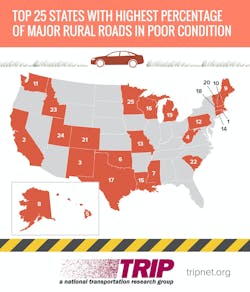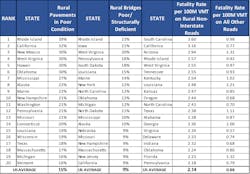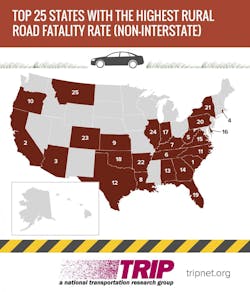Report says U.S. rural roads, bridges have significant deficiencies, fatality rates
America’s rural transportation system is in need of repairs and modernization to support economic growth in the nation’s heartland, according to a new report recently released by TRIP, a national transportation research nonprofit.
The report, Rural Connections: Challenges and Opportunities in America’s Heartland, evaluates the safety and condition of the nation’s rural roads and bridges and finds that the nation’s rural transportation system is in need of immediate improvements to address deficient roads and bridges, high crash rates, and inadequate connectivity and capacity. The chart below shows the states with the highest rate of rural pavements in poor condition, states with the highest share of rural bridges that are rated poor/structurally deficient, and states with the highest fatality rates on non-Interstate, rural roads.
The report finds that the nation’s rural roads and bridges have significant deficiencies. Fifteen percent of U.S. rural roads are rated in poor condition, while 21% are in mediocre condition. Seventeen percent of the nation’s rural roads are in fair condition and the remaining 47% are in good condition. Nine percent of the nation’s rural bridges are rated in poor/structurally deficient condition, meaning there is significant deterioration to the major components of the bridge. Poor/structurally deficient bridges are often posted for lower weight or closed to traffic, restricting or redirecting large vehicles. Forty-six percent of rural bridges are rated fair. A fair rating indicates that a bridge’s structural elements are sound but minor deterioration has occurred to the bridge’s deck, substructure or superstructure.
In addition to deteriorated roads and bridges, the TRIP report finds that traffic crashes and fatalities on rural non-Interstate roads are disproportionately high, occurring at a rate nearly 2.5 times higher than on all other roads. In 2017, non-Interstate rural roads had a traffic fatality rate of 2.14 deaths for every 100 million vehicle miles of travel, compared to a fatality rate on all other roads of 0.88 deaths per 100 million vehicle miles of travel. Rural roads are more likely to have narrow lanes, limited shoulders, sharp curves, exposed hazards, pavement drop-offs, steep slopes and limited clear zones along roadsides.
America’s rural transportation system provides the first and last link in the supply chain from farm to market, connects manufacturers to their customers, supports the tourism industry, and enables the production of energy, food and fiber. Rural Americans are more reliant on the quality of their transportation system than their urban counterparts, TRIP noted. The TRIP report finds that the U.S. needs to implement transportation improvements that will improve rural transportation connectivity, safety, and conditions to provide the nation’s small communities and rural areas with safe and efficient access to support quality of life and enhance economic productivity.
----------
Source: TRIP



